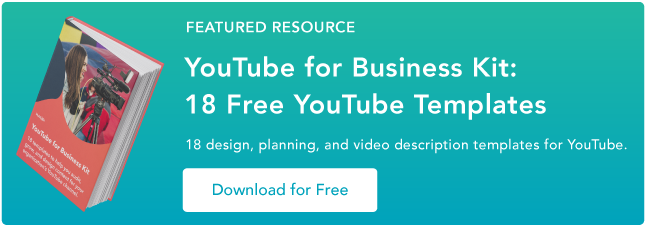YouTube competitor analysis is essential to your video content strategy this year. Take it from me — I lead HubSpot’s YouTube growth strategy, overseeing content strategy, trend monitoring, performance reporting, and competitor analysis.

As of 2024, YouTube is the biggest video-sharing platform and the second-biggest social media in the world, with over 2.70 billion users. And believe me, it’s not slowing down anytime soon, the number of YouTube’s global users is estimated to reach 2.85 billion by 2025.
With this ongoing video growth on the horizon, it’s important to assess your competition.
Table of Contents
What is a competitor analysis on YouTube?
Competitor analysis on YouTube involves studying the content created by competitors in your desired niche or subject matter area. These insights help you understand your competitors’ strengths, weaknesses, and strategies.
This analysis can be conducted on a monthly, quarterly, or annual basis. Your goal is to learn what competitors are doing well and to emulate it in your own style.
You’ll also want to figure out what they aren’t doing so you can do it and stand out in the competitive YouTube landscape.
Why is a YouTube competitor analysis important?
Competitor analysis helps you understand the competitive landscape for your target market.
This is crucial in my role because it allows me to gain valuable insights into what other brands are doing on the platform.
By understanding competitors’ strategies, content performance, audience engagement tactics, and overall presence on YouTube, I can identify industry trends and pinpoint areas where content gaps exist.
I can also discover opportunities for improvement, and make informed decisions to stay ahead.
This analysis will help you better understand your audience and create a comprehensive YouTube content strategy.
How to Do Competitor Analysis on YouTube
Step 1: Create a list of your top competitors.
You should start your competitor analysis by identifying five to ten YouTube channels that are competitors.
These competitors can be based on your specific industry (e.g., cosmetics), niche (e.g., clean, cruelty-free cosmetics), and/or target audience (e.g., environmentally conscious cosmetics consumers).
In my experience here at HubSpot, I’ve learned the art of selecting a diverse range of competitors.
This thoughtful approach acknowledges the presence of niche competitors within topics we cover while aligning seamlessly with our channels that may explore broader subjects.
I find these competitors by searching for specific topics I want to cover on YouTube and by finding the top-ranking videos for each search result on YouTube.
In the example below, you can see the top-ranking results for the topic “Instagram marketing,” based on the results, Adam Erhart and Learn With Shopify may be the current key competitors for this topic.

You can also use YouTube Shorts to identify key competitors.
Start by searching for the focus keyword and clicking the “Shorts” tab.
For example, the current top-ranking Shorts competitors for the keyword “Instagram marketing” are Vanessa Lau and Adam Erhart.
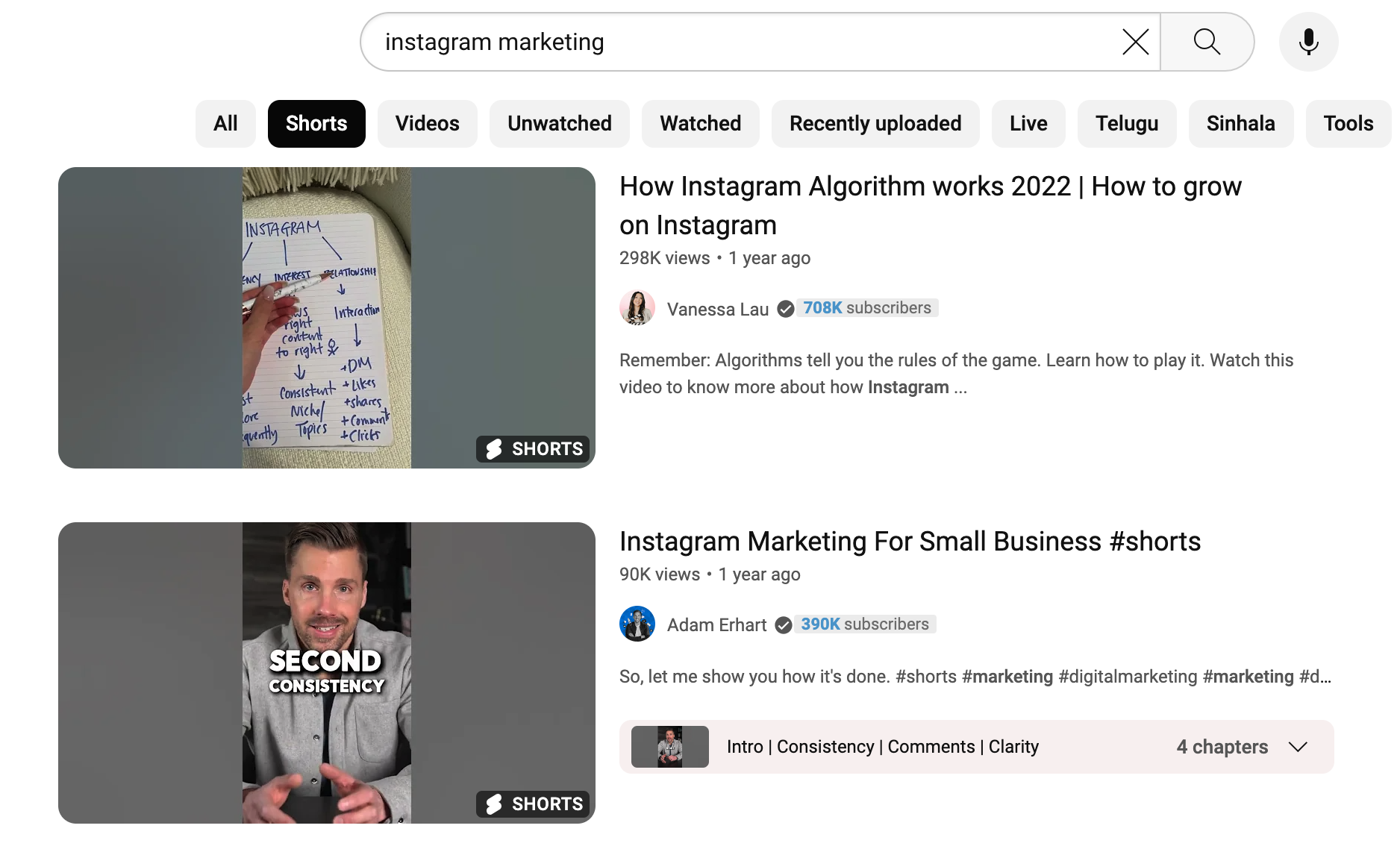
Be sure to go to the YouTube creator’s account to review the videos they’ve posted in the past year to ensure that the topics they cover align with the overall content pillars or topics that you intend to cover on your channel.
Step 2: Analyze competitor YouTube videos.
Once you’ve identified 5-10 competitors, it’s time to analyze the content your competitors have published for the year.
For example, I just conducted a 2024 competitor analysis for HubSpot analyzing all the videos created by our competitors in 2023.
I recommend considering the following things when completing a competitor analysis:
- What topics are your competitors discussing?
- What type of videos are they making (tutorials, vlogs, reviews, etc.)?
- How often are they publishing content?
- How long are their videos?
- What are their most popular videos from the past year?
- Do competitors have a video series or recurring theme?
- Are competitors using interactive elements such as polls, clickable links, or end-screen features?
Let’s continue with the Instagram marketing example from Step 1.
Below are examples of data and information you may find from your analysis of top-ranking Instagram marketing competitors:
- Topics discussed: General Instagram marketing, Instagram updates/trends, Instagram marketing tools, Instagram marketing strategy
- Type of videos: Tips, how-to tutorials, explainers
- Publishing cadence: Once per week
- Length of videos: 10-20 minutes
- Popular videos: “Instagram Marketing for Business” / “How to Create a Instagram Content Planner Calendar”
Pro Tip: I like to explore how competitors organize their playlists and video series. I assess the strategy behind grouping certain videos and creating a seamless viewing experience.
And don’t skip out on thumbnail research. I pay attention to the visual style of our competitors’ popular video thumbnails. I also identify trends in design, color schemes, and elements that grab attention.
Once you’ve aggregated this data, you can use it to identify and make note of any recurring themes.
These insights will be instrumental in crafting your content strategy because it will allow you to create content that resonates with your target audience and ensures your channel is competitive with other creators in a similar landscape.
Step 3: Identify SEO keywords and strategies.
Next, it’s time to examine your competitor’s video titles, descriptions, and tags.
This will allow you to understand how your competitors are optimizing their videos for YouTube search.
You can use competitor research in combination with SEO tools like TubeBuddy and VidIQ to review the monthly search volume of the keywords your competitors are using.
Video Titles
For video titles, examine how each competing video is structured and identify any common keywords/phrases. These titles communicate what keywords resonate with your audience and inform their searches on YouTube.
This analysis will inform how you shape your titles to include keywords or phrases that your target audience wants to see.
In our Instagram marketing example, the title in the top-ranking video says: “The Complete INSTAGRAM FOR BUSINESS GUIDE (Reels, Stories, Verification, Instagram Shopping & More!)”.
This title includes the focus keyword “Instagram for business” in all caps, it indicates that it is the complete guide, and gives a preview of what will be discussed in the video.

Video Descriptions
For video descriptions, analyze your competitor’s video description based on structure, if/where they include relevant keywords, links, and additional context. This will help develop the framework for your video descriptions.
In our Instagram marketing example, a description from a top-ranking social media marketing competitor may say: “Instagram For Business Tutorial: Grow your Instagram and use it to drive your online sales.”
This indicates that the competitor is using the primary focus word (“Instagram for business”) within the first sentence and tells the viewer exactly what to expect in the video.
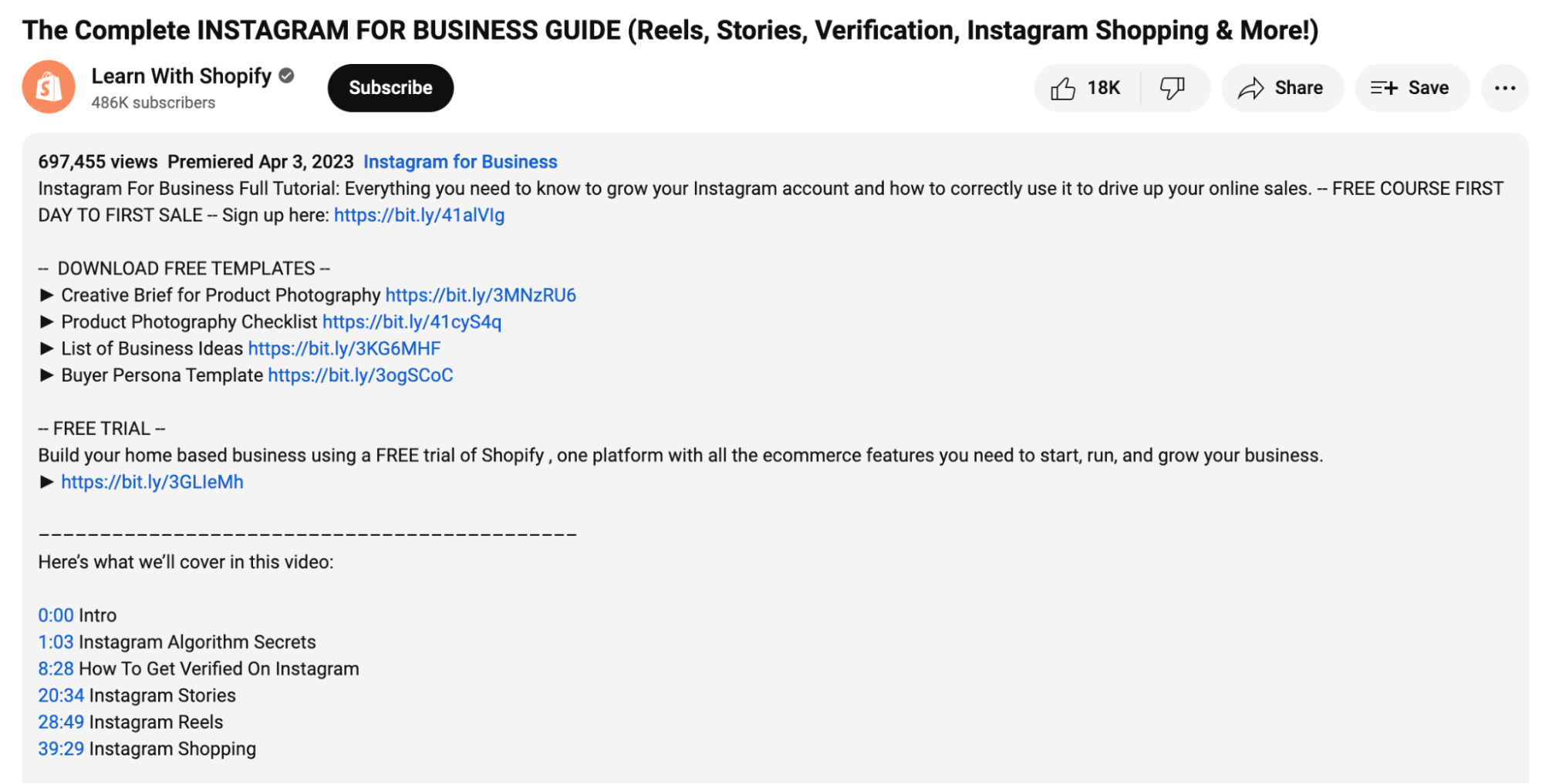
Video Tags
For video tags, make note of any tags competitors use to enhance discoverability.
Video tags help categorize your content and indicate to your viewers what your videos are about.
Using the appropriate video tags for your video will best allow YouTube to share your content with viewers who are interested in that content.
In our Instagram marketing example, video tags from a top-ranking Instagram competitor may be: #instagramtutorials #instagramforbusiness.
This communicates to YouTube and the viewer that they will receive information about Instagram, a tutorial, and specifically for businesses.
Pro Tip: Beyond content analysis, I dive into competitors’ audience interactions. I identify recurring keywords in comments and observe how competitors engage. Pinned comments offer valuable insights into favored terms. I then leverage these findings to tailor my engagement strategy.
Step 4: Observe community engagement and audience feedback.
In this step, I like to observe how competitors engage with their YouTube community and how the audience responds to their content.
Community Engagement
Community engagement can help a creator connect with their audience.
You’ll want to look into how your competitors are using community features on YouTube to engage with their viewers.
I look for patterns in how competitors respond to comments, run polls, and address feedback.
Further, you’ll want to keep a close eye on whether your competitors are partnering with other creators to create their content. This will allow you to refine and adapt your community engagement strategy.
For example, under the “Instagram for business” video a viewer left a comment asking for clarity about a part of the video. Learn with Shopify responded and provided additional resources for the viewer.
This indicates to the Channel’s audience that Learn with Shopify is actively reviewing comments and looking to answer questions and provide educational resources for their audience.
This is something you’ll want to make note of and incorporate into your strategy.
Conversely, if your competitor has several questions under their videos that are left unanswered, that may serve as a point of differentiation for your videos.
You may want to create videos about those unanswered questions, and/or create an engaging presence in your comments to harbor a greater sense of community with your audience.
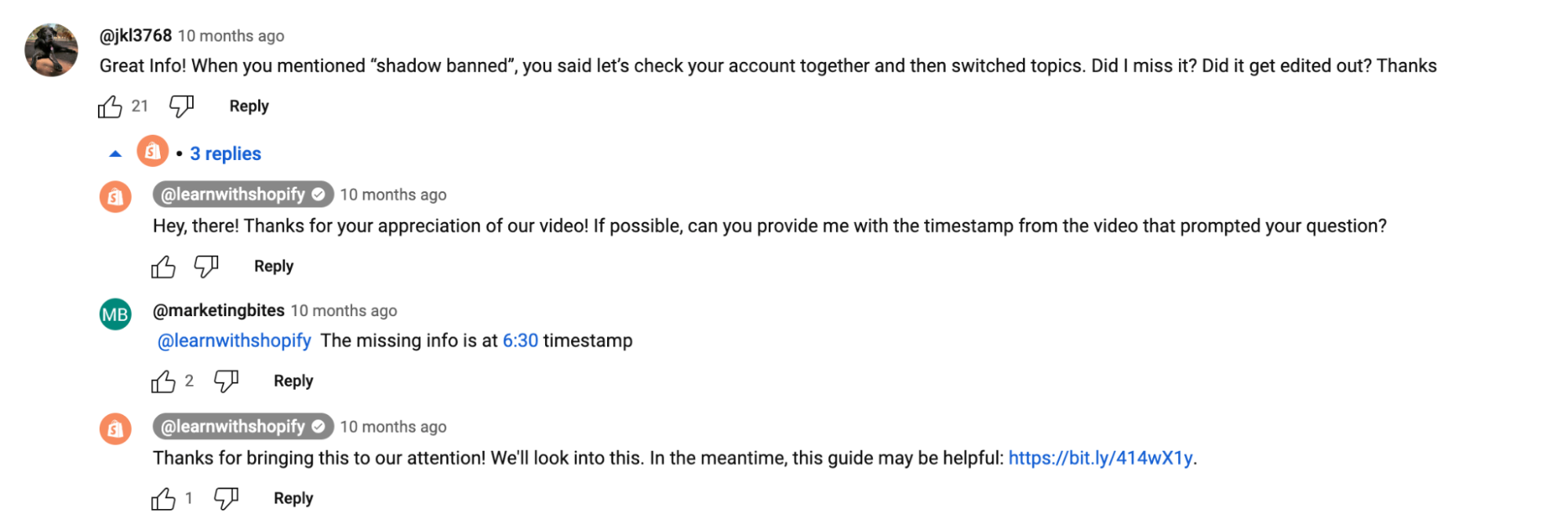
Audience Feedback
Analyzing the audience interaction on competitor videos such as likes will also allow you to understand how the audience received the video.
For example, if I notice that a video has a lot of views and ranks #1 for the topic, but it has limited likes, this may suggest that the viewers did not enjoy the content that was delivered.
Reviewing comments on competitor videos can give you a lot of helpful insight too. Viewer comments may tell you exactly what they liked or disliked about the video, what they want to see next, and what they wished was included.
These comments can set the stage for what you should include or avoid in your videos.
In the example below, under the “Instagram for business” video, viewers left several positive comments about how much they enjoyed the video. This is a great indicator that the video successfully delivered value to viewers.
You can take inspiration from this video by analyzing how the video is structured, how information is presented, the length of the video, along with other insights.
Remember, taking inspiration from a competitor does not mean copying. You want to create original content that delivers value to your audience independently and originally.
Viewers don’t need another video like this, they need something unique.
Further, there is a comment requesting a step-by-step guide on how to create videos. This comment indicates that there is a desire for this type of video.
If it fits your content strategy, this may be a video that you can create for your audience.
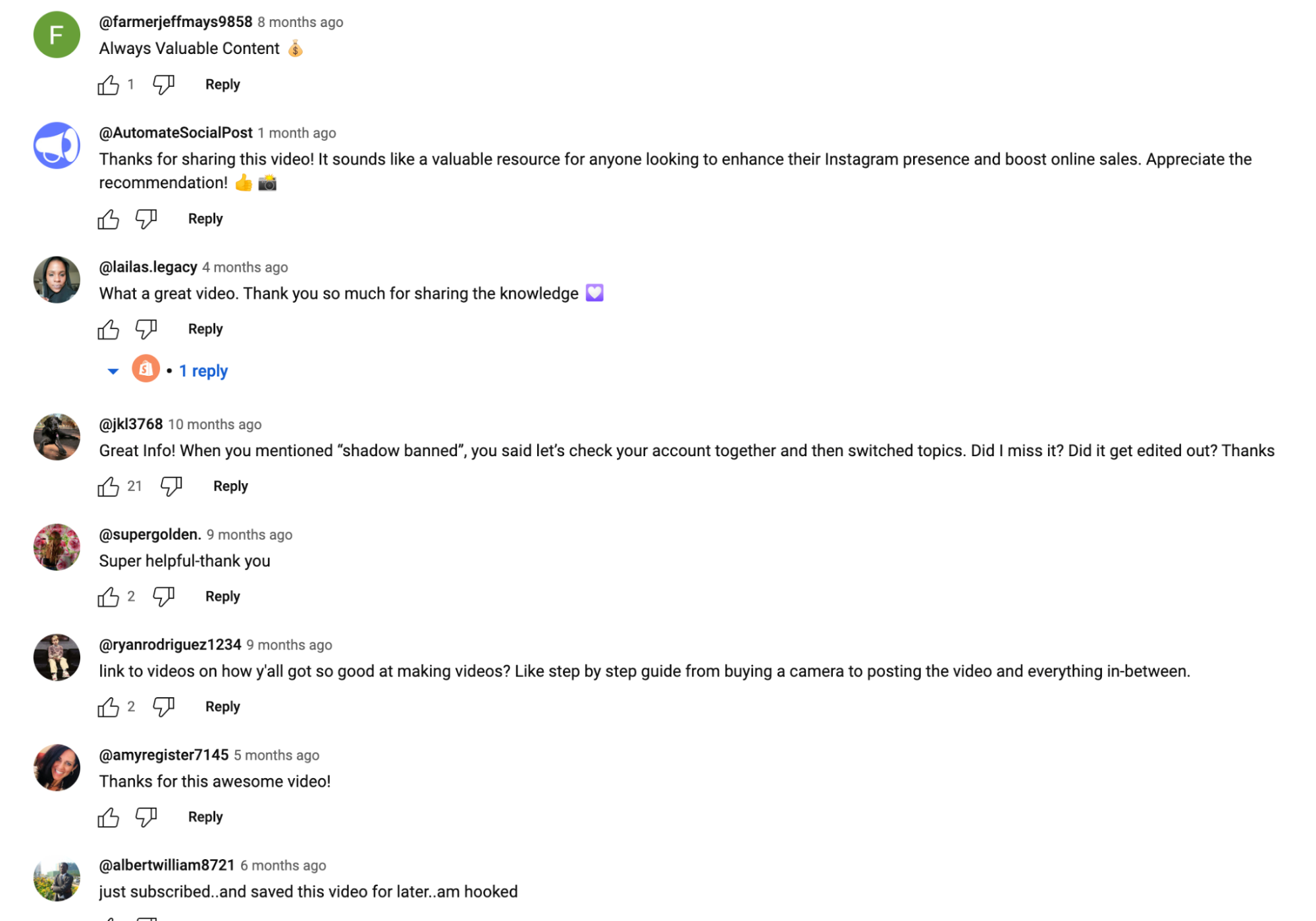
Step 5: Identify content gaps and use them to stand out.
It’s time to take all of the competitor insights you’ve found and turn them into content strategies for your YouTube channel.
You’ve evaluated and made note of what your competitors are doing well and where they are falling short. You will try to use what they’re using well as inspiration.
The areas where your competitors are falling short are called content gaps.
To round out our Instagram marketing example, let’s say I noticed that competitors are making long videos without outlined chapters.
This would be a great chance to not only adopt their successful elements but to also enhance the viewer experience by incorporating clear chapter markers.
This strategic differentiation is your key to standing out amidst competitors and delivering more refined and engaging video content.
Pro Tip: I like to explore how competitors use captions and transcriptions. I also assess whether they provide engaging supplementary content. For example, HubSpot provides its viewers with free content offers on the HubSpot Marketing Channel as supplementary educational content.
Level up your content strategy with a competitor analysis.
YouTube competitor research can help take your content strategy to the next level.
Competitor research and analysis serve as a compass for guiding your content strategy, offering insights into trends, audience engagement, and content gaps for opportunity.
These insights lay the foundation for a strong well-informed content strategy.
The digital landscape is continuously evolving and with that it requires us to both remain vigilant and flexible. These competitor insights lay the groundwork for your content strategy, but they are meant to evolve with emerging trends, audience preferences, and platform changes.
While adhering to the framework you’ve outlined from competitor research, you should continue to experiment and test new strategies.
With the combination of competitor insights, experimentation, and monitoring trends, you’ll know how to create content that your audience wants to see.
That’s all from me for now — good luck with your research.
- SEO Powered Content & PR Distribution. Get Amplified Today.
- PlatoData.Network Vertical Generative Ai. Empower Yourself. Access Here.
- PlatoAiStream. Web3 Intelligence. Knowledge Amplified. Access Here.
- PlatoESG. Carbon, CleanTech, Energy, Environment, Solar, Waste Management. Access Here.
- PlatoHealth. Biotech and Clinical Trials Intelligence. Access Here.
- Source: https://blog.hubspot.com/marketing/youtube-competitor-analysis


![→ Free Templates: How to Use YouTube for Business [Download Now]](https://zephyrnet.com/wp-content/uploads/2024/03/youtube-competitor-analysis-how-i-do-it-in-5-easy-steps.png)
